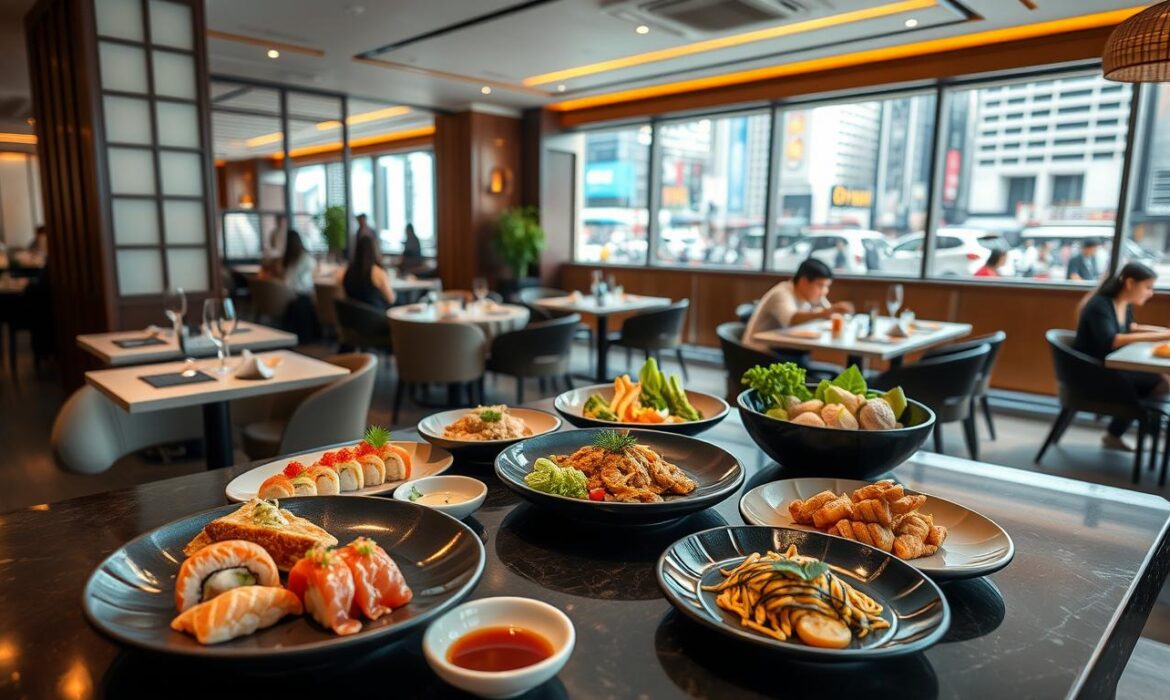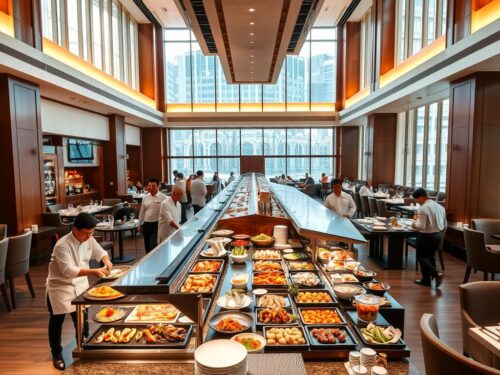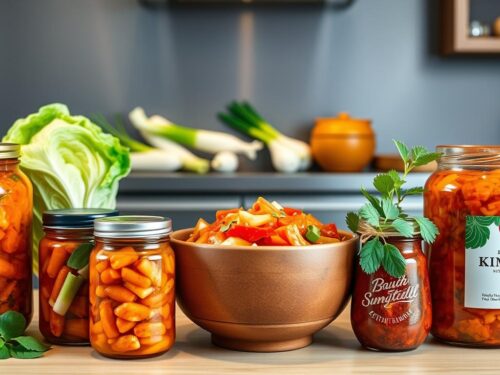Singapore stands out as a top destination for authentic and innovative dining experiences. The city’s vibrant culinary scene blends traditional techniques with multicultural influences, creating a unique fusion of flavors.
From MICHELIN-starred establishments to cozy izakayas, there’s something for every palate. Chefs here skillfully craft dishes using premium ingredients sourced directly from Japan. Whether you crave sushi, ramen, or wagyu, the options are diverse and impressive.
This guide highlights must-try spots that showcase the richness of Japanese cuisine. Each location offers a distinct atmosphere, ensuring memorable meals for every occasion.
Key Takeaways
- Singapore is a hotspot for high-quality Japanese dining.
- Traditional techniques meet multicultural influences.
- Premium ingredients are imported directly from Japan.
- Options range from fine dining to casual eateries.
- Sushi, ramen, and wagyu are standout specialties.
Introduction to Japanese Food in Singapore
The rich history of Japanese culinary traditions in Singapore dates back over a century. Early immigrants brought techniques like Edomae sushi and kaiseki, laying the foundation for today’s vibrant scene.
Singapore’s role as a shipping hub ensures chefs access fresh ingredients daily. From seasonal seafood to premium wagyu, quality is never compromised. This logistical edge keeps dishes authentic yet innovative.
Local flavors blend seamlessly with tradition. Think binchotan-grilled meats paired with tropical fruit glazes or ramen broths infused with spices. The result? A unique dining experience that honors roots while embracing creativity.
Dining formats cater to every mood:
- Omakase counters: Chef-curated menus showcasing knife skills.
- Ramen joints: Hearty bowls with rich, slow-cooked broths.
- Izakayas: Casual spots for skewers and sake.
The MICHELIN Guide repeatedly highlights Singapore’s Japanese restaurants, praising their balance of precision and passion. Whether you seek tradition or reinvention, the city delivers.
Sushi: A Japanese Staple in Singapore
From intimate counters to lavish settings, sushi takes center stage here. The city’s chefs masterfully balance tradition with innovation, offering everything from Edomae-style cuts to bold fusion creations. Freshness is non-negotiable—think daily-flown seafood and hand-selected produce.
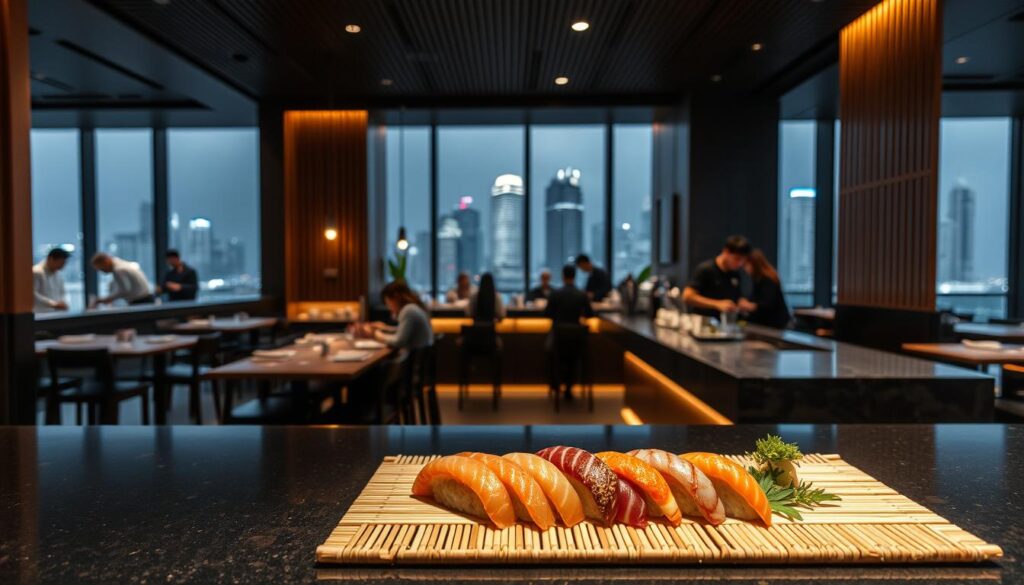
Esora: Innovative Sushi Experience
Esora redefines omakase with a Japanese-French twist. Seasonal ingredients meet artistic plating, like washi paper-lined trays and custom ceramicware. The $250+ menu includes tea pairings, highlighting rare matcha and sencha blends.
With only 18 seats, the counter offers an immersive dining experience. Watch chefs craft each course with knife skills honed in Tokyo’s top kitchens.
Waku Ghin: Contemporary Sushi Delights
At Marina Bay Sands, Waku Ghin impresses with $400+ tasting menus. The Classic option features Hokkaido uni, while the Seasonal lineup showcases global luxuries like Alba truffles.
Post-meal, the lounge serves desserts with skyline views. It’s a stark contrast to Esora’s coziness—here, grandeur complements the sushi.
- Seating: Esora’s 18-seat counter vs. Waku Ghin’s chef’s table.
- Price: $250 (Esora) vs. $400+ (Waku Ghin).
- Specialty: Tea pairings vs. lounge desserts.
Ramen: Comfort in a Bowl
Nothing warms the soul like a steaming bowl of ramen, and Singapore’s scene delivers unforgettable flavours. Whether you crave a quick lunch or a hearty meal, the city’s top spots master both tradition and innovation.
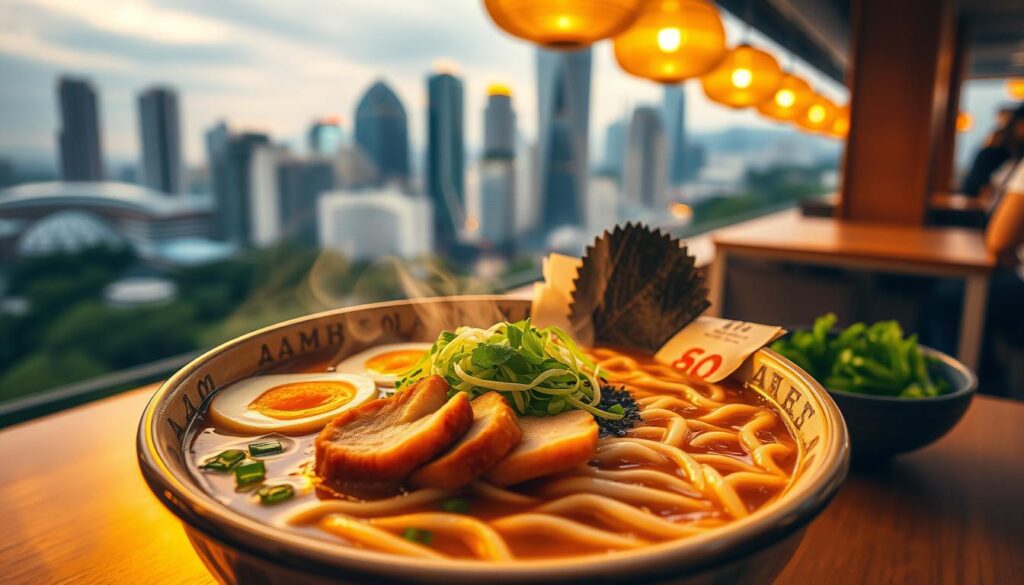
Brothers Ramen: Affordable and Delicious
Their signature broth simmers for 12 hours, blending pork bones into a creamy, umami-rich base. At $14.90++, the Megamen Dry stands out—tossed noodles with spicy minced pork and a soft-boiled egg.
Pro tip: Visit early to beat CBD crowds. Their queue management includes real-time updates via app.
Bari Uma: Rich and Flavorful Broths
Hiroshima-style shoyu ramen shines here. The broth cooks for 7 hours with dried sardines and bonito, layered with thick-cut chashu. Try the ajitama-uma ($15.90++), topped with a marinated egg that oozes golden yolk.
Vegetarian? Their mushroom-based broth swaps meat without skimping on depth.
“The first slurp tells you everything—no shortcuts, just patience and craft.”
- Must-try: Brothers’ spicy dry noodles vs. Bari Uma’s egg-topped classic.
- Price: $14.90++ (Brothers) vs. $15.90++ (Bari Uma).
- Extras: Ajitama eggs or extra nori elevate either bowl.
Omakase: A Chef’s Masterpiece
Omakase dining transforms meals into an art form, where chefs craft unforgettable experiences. In Singapore, this Japanese dining style ranges from lavish multi-course affairs to wallet-friendly set menus. Each venue offers a distinct take on chef-curated creativity.
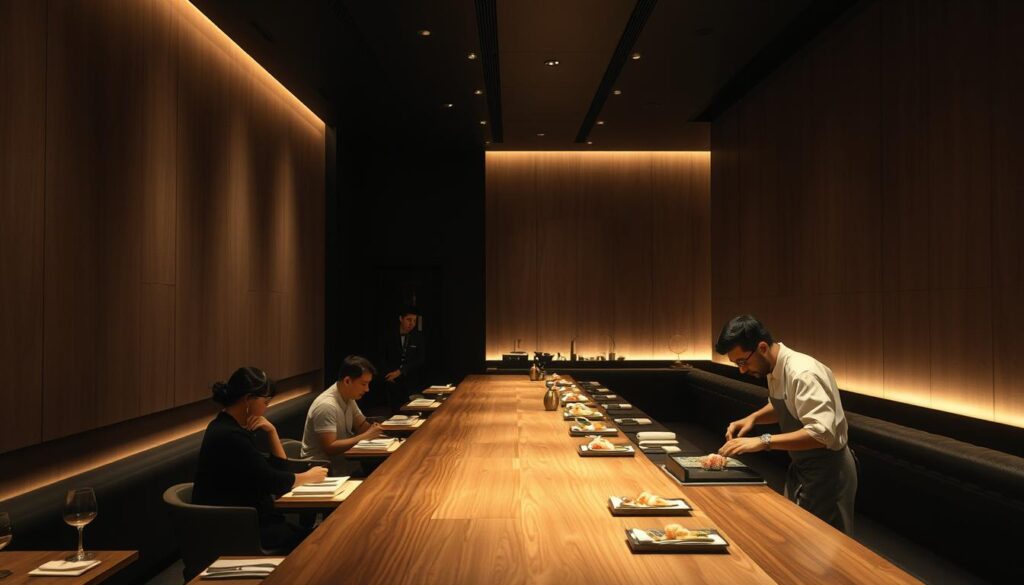
Shunsui: Multi-Chef Omakase
At Shunsui’s 20-seat counter, three chefs collaborate on menus ($180–$300). The theatrical lighting enhances the “nose-to-tail” fish butchery, while 32-month-aged Ozaki wagyu stars in meat courses. Book one of two nightly seatings for interactive banter.
Haku Sushi: Affordable Omakase
Great World City’s Haku Sushi delivers an 8-course lunch ($68++) focused on seasonal seafood. Share the space with Kou Teppan for teppanyaki add-ons. Walk-ins welcome—a rarity for quality omakase.
| Feature | Shunsui | Haku Sushi |
|---|---|---|
| Price | $180–$300 | $68++ |
| Focus | Wagyu & whole fish | Seasonal seafood |
| Booking | Two seatings | Walk-ins accepted |
| Extras | Chef interactions | Teppanyaki options |
Whether splurging or saving, these spots prove omakase adapts to every appetite. The contrast? Shunsui’s drama versus Haku’s laid-back meals—both unforgettable.
Wagyu: The Ultimate Beef Experience
Few dishes command as much respect as premium wagyu, where marbling meets mastery. Singapore’s top restaurants showcase this luxurious beef through diverse preparations, from traditional grills to innovative cuts.
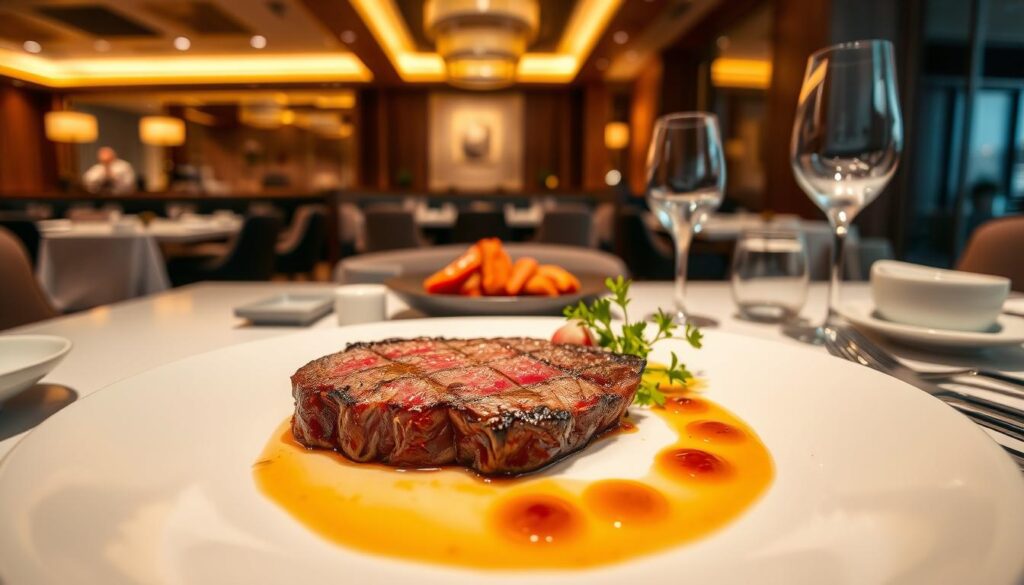
Ushidoki Wagyu Kaiseki: Nose-to-Tail Dining
Under skylight counter seating, chefs butcher 32-36-month Ozaki wagyu in-house. Their $250+ kaiseki menu features 10 courses highlighting charcoal-grilled cuts and 90% Japanese-sourced produce.
Pairings elevate the experience—sake flights complement the beef’s richness. The theatrical open kitchen lets you watch every precise slice.
Gyukatsu Kyoto Katsugyu: Crispy Wagyu Cutlets
For a contrasting take, try A5 Miyazaki sirloin encased in golden panko ($55++). The signature dish comes with mountain potato dip and “half & half” combo plates for variety.
Unlike Ushidoki’s lengthy meals, Gyukatsu focuses on satisfying rice bowl sets. Their global expansion strategy brings this comfort food to new audiences.
“The crunch gives way to butter-soft beef—a textural revelation.”
- Preparation: Ushidoki’s binchotan grilling vs. Gyukatsu’s deep-fried crust
- Portions: Multi-course kaiseki vs. single-bowl satisfaction
- Drinks: Premium sake pairings vs. hearty miso soups
Izakaya: Casual Japanese Dining
For a laid-back yet flavorful experience, izakayas bring the heart of Japan’s after-work culture to life. These cozy spots blend bar vibes with shareable plates, perfect for groups or solo diners.
Public Izakaya: Authentic Izakaya Experience
Nestled in Tanjong Pagar, Public Izakaya buzzes with late-night crowds. Their $22++ oden sets and jaga mentaiko (potato with spicy cod roe) are crowd-pleasers. Arrive early—the lively atmosphere fills up fast.
Don’t miss the karami goma mazesoba, a spicy sesame noodle dish. Pair it with their sake bombs for a true izakaya experience.
Kazu Sumiyaki: Skewers and More
Since 1993, Kazu Sumiyaki has served $5++ skewers at Cuppage Plaza. Their tsukune (chicken meatballs) and ochazuke (tea-rice) cater to expats and locals alike.
Prefer cocktails? Their highball menu complements the smoky grill flavors. The intimate counter seating encourages chef banter.
| Feature | Public Izakaya | Kazu Sumiyaki |
|---|---|---|
| Signature Dish | Karami goma mazesoba | Tsukune skewers |
| Drinks | Sake bombs | Highball cocktails |
| Group Dining | Large tables | Counter seating |
| Price Range | $22++ oden sets | $5++ skewers |
“The tsukune here melts in your mouth—worth every penny.”
Unagi: Grilled Eel Delicacies
Grilled eel, or unagi, holds a special place in Japanese cuisine with its rich, smoky flavor. This delicacy is prized for its tender texture and sweet-savory glaze, often served over fluffy rice. Whether you prefer a lavish meal or a quick bite, Singapore’s restaurants deliver unforgettable versions.
Unagi Yondaime Kikukawa: Michelin-Approved Excellence
Since 1932, Kikukawa has perfected unagi using binchotan grilling. Their $48++ kabayaki set includes eel liver soup and pickles. The Michelin Bib Gourmand spotlights their mastery—each bite melts with caramelized tare sauce.
Summer brings limited-edition promotions, like chilled unagi sushi. Pair your meal with a crisp sake for the full experience.
Una Una: Affordable and Flavorful
At Bugis+, Una Una offers hitsumabushi-style donburi for $9.80++. This Nagoya-inspired dish lets you enjoy eel four ways: plain, with condiments, in dashi broth, or as chazuke.
Their tamagoyaki (sweet omelet) adds a comforting touch. It’s a wallet-friendly way to savor this signature of Japanese dishes.
“The contrast between crispy skin and buttery flesh is what makes unagi unforgettable.”
- Grilling: Kikukawa’s binchotan vs. Una Una’s quick-sear method.
- Price: $48++ (premium) vs. $9.80++ (casual).
- Sides: Eel liver soup or tamagoyaki—both elevate the dish.
Japanese Curry: Comfort Food Redefined
Japanese curry brings warmth and depth to every bite, with its rich roux and tender ingredients. Unlike its spicier counterparts, this dish balances sweetness and umami, making it a crowd-pleaser. Whether paired with crispy cutlets or udon, it’s a versatile food that adapts to all tastes.
Maji Curry: Award-Winning Japanese Curry
Twice crowned at the Japan Curry Grand Prix (2018, 2022), Maji Curry lets you customize spice levels from 1-10. Their menu features quirky twists like cheese-topped curry and plant-based options. The tonkatsu omelette combo is a must-try—crispy pork cutlet meets fluffy eggs.
Tempura Udon by Mizuya: Curry and Tempura Combo
At $16++, Mizuya’s salmon tempura curry udon set is a steal. Thin udon noodles soak up the mild broth, contrasting with thicker varieties elsewhere. Their aburi chirashi add-on pairs seared fish with curry for a textured bite.
“Maji’s level 5 spice hits the sweet spot—warming but not overwhelming.”
- Heat Levels: Maji’s adjustable scale vs. Mizuya’s gentle default.
- Noodles: Mizuya’s delicate udon vs. standard thick strands.
- Locations: Maji at Square 2 vs. Mizuya in Tanjong Pagar.
Conclusion: The Best Japanese Food in Singapore
From high-end restaurants to cozy hidden gems, the options are as diverse as they are delicious. Whether you’re splurging on a MICHELIN-starred dining experience or enjoying a wallet-friendly meal, there’s something for every taste and budget.
Singapore’s cuisine scene stands out by blending tradition with creativity. Seasonal ingredients and chef-driven menus keep the offerings fresh and exciting. For those eager to explore, this list is just the beginning.
Pro tip: Book ahead for popular spots or visit during off-peak hours. Discover more top picks to plan your next flavorful adventure.

